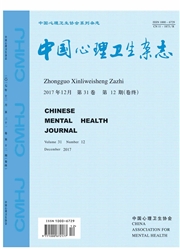

 中文摘要:
中文摘要:
目的:探讨强迫症患者中不同类型的早年创伤、人格特质与临床症状三者之间的相互作用关系,以及适应不良的人格特质在早年创伤与强迫症状间的中介作用。方法:选取147例符合精神障碍诊断与统计手册第4版(DSM-IV)诊断标准的强迫症患者,使用耶鲁-布朗强迫症状量表(Y-BOCS)测量被试的强迫症状严重度,早年创伤问卷-自评版(ETI-SF)测量其早年创伤经历,NEO大五人格量表(NEO-FFI)测量其人格特质。结果:ETI-SF中情感虐待分量表得分与Y-BOCS总分呈正相关(r=0.19,P〈0.05),NEO-FFI中神经质人格得分与Y-BOCS总分呈正相关(r=0.31,P〈0.001),宜人性人格得分与Y-BOCS总分呈负相关(r=-0.18,P〈0.05)。通径分析显示神经质人格在情感虐待与强迫症状间起完全中介作用,中介作用大小为0.107(95%CI:0.04-0.19,P〈0.05)。结论:早年情感虐待可能与强迫症状呈正相关,而神经质人格在情感虐待与强迫症状之间发挥了完全中介作用。
 英文摘要:
英文摘要:
Objective: To explore the tri-relationship among the different types of early trauma, personality traits and obsessive-compulsive symptoms, and to analysis the mediating effects of maladaptive personality traits between early trauma and obsessive-compulsive symptoms. Methods: A total of 147 obsessive-compulsive patients were selected. The Yale-Brown obsessive-compulsive scale (Y-BOCS) was used to measure the degree of obsessive-compulsive symptoms, the Early Trauma Inventory Short Form (ETI-SF) was used to measure the early trauma experience, the NEO Five-Factor Inventory ( NEO-FFI ) was used to measure the personality characteristics. Results: The emotional abuse subscale scores of ETI-SF were positively correlated with the total scores of Y-BOCS (r = 0. 19; P 〈 0. 05), the neuroticism scores of NEO-FFI were positively correlated with the to- tal scores of Y-BOCS (r =0. 31, P 〈0. 001), while the agreeableness scores of NEO-FFI were negatively correlated with the total scores of Y-BOCS (r = -0. 18, P 〈0. 05). The pathway analysis showed the indirect effects from emotional abuse to Y-BOCS via neuroticism were 0. 107 (95% CI: 0. 04 - 0. 19, P 〈 0. 05), the neuroticism play a completely mediated role. Conclusion: Early emotional abuse may be positively correlated with obsessive-compulsive symptoms, while the neuroticism may play a completely mediating role between the early emotional abuse and obsessive-compulsive symptoms.
 同期刊论文项目
同期刊论文项目
 同项目期刊论文
同项目期刊论文
 期刊信息
期刊信息
